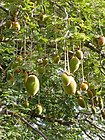Note: This is a project under development. The articles on this wiki are just being initiated and broadly incomplete. You can Help creating new pages.
Adansonia digitata - Baobab
Baobab is a succulent, deciduous tree that can grow up to around 20 metres tall, often with a very sparse crown, especially in the drier parts of its range. The swollen, urn-shaped bole will eventually become very wide, often exceeding the diameter of the crown, and can be up to 10 metres across. This is a true multi-purpose tree with a very wide range of used for local people. There is evidence that the baobab fruit was being sold in the markets of Egypt over 4,500 years ago. It is still widely used by local peoples in the areas of the tropics where it grows wild or is naturalised, and is often left standing when land is cleared for cultivation.
Uses
Parts Used
Chemical Composition
Several compounds were isolated from fruit pulp, seed oil, root isolates terpenoids, flavonoids, steroids, vitamins, amino acids, carbohydrates and lipids. 10 Aromatic compounds including isopropyl myristate and nonanal were identified in fruit pulp. [2]
Common names
| Language | Common name |
|---|---|
| Kannada | aane hunase, aane hunise, baobaab, brahmaamlika, muggi maavu |
| Hindi | gorakh-imli, gorakh-chinch |
| Malayalam | |
| Tamil | aanaipuliya maram, paparapuli, totimaram |
| Telugu | brahmamlika, maggimaavu, seemachinta |
| Marathi | gorak-chinch, baubab, chori chinch |
| Gujarathi | |
| Punjabi | |
| Kashmiri | |
| Sanskrit | chitrala, choramli, dirghadandi, gajabala, gandhabahula, gopali, gorakh-chinch |
| English | baobab |
[3]
Properties
Reference: Dravya - Substance, Rasa - Taste, Guna - Qualities, Veerya - Potency, Vipaka - Post-digesion effect, Karma - Pharmacological activity, Prabhava - Therepeutics.
Dravya
Rasa
Guna
Veerya
Vipaka
Karma
Prabhava
Habit
Identification
Leaf
| Kind | Shape | Feature |
|---|---|---|
| Digitate | Alternate | digitately 3- to 9-foliate; leaflets oblong to ovate, 5-15 x 3-7 cm, lower leaflets being the smallest and terminal leaflet the largest; leaflets dark green, softly hairs; lateral veins looping; apex and base tapering, margin entire; petiole up to 12 cm long; petiolule sessile or subsessile. |
Flower
| Type | Size | Color and composition | Stamen | More information |
|---|---|---|---|---|
| Bisexual | Axillary | White | Many | Flowers a waxy white, up to 20 cm in diameter, axillary, solitary, pendulous, bisexual. Calyx deeply lobed, with silky hairs inside; petals crinkly, spreading . Stamens many on a large central column . Ovary superior, 5-10 loculed; ovules many |
Fruit
| Type | Size | Mass | Appearance | Seeds | More information |
|---|---|---|---|---|---|
| 12cm | Fruit ovoid, 12 cm or more in length, with a hard, woody shell, covered with yellowish-grey velvety hairs, indehiscent; seeds smooth, embedded in a whitish powdery pulp. |
Other features
List of Ayurvedic medicine in which the herb is used
Where to get the saplings
Mode of Propagation
How to plant/cultivate
Seed - sow in containers. Germination is usually 90-100% and takes 1-3 months at 21c. Germination is more rapid and successful if the seeds are first nicked or boiling water is poured on them, after which they are left to soak for 24 hours. Soaking in water overnight softens the seed coat and makes water absorption for germination easy. When the seed coat is nicked it may take only 6 days to germinate, though it is more likely to be 15 - 40 days. It is preferable to sow the seed directly into the soil. When seedlings emerge it is best to shade them for 8 days, then provide half shade for 4 - 7 days before exposing them to full sun. Seedlings need to be 3 - 4 months old, reaching a height of 40 - 50cm, before transplanting. The seed can be stored for at least 4 years at room temperature with no loss of viability [5]
Commonly seen growing in areas
Photo Gallery
References
External Links
- [ ]
- [ ]
- [ ]
- Pages with broken file links
- Ayurvedic Herbs known to be helpful to treat Diabetes
- Ayurvedic Herbs known to be helpful to treat Rheumatism
- Ayurvedic Herbs known to be helpful to treat Inflammation
- Ayurvedic Herbs known to be helpful to treat Fever
- Ayurvedic Herbs known to be helpful to treat Sores
- Ayurvedic Herbs known to be helpful to treat Dysentery
- Herbs with Bark used in medicine
- Herbs with Fruits used in medicine
- Herbs with Gum used in medicine
- Herbs with Roots used in medicine
- Herbs with common name in Kannada
- Herbs with common name in Hindi
- Herbs with common name in Tamil
- Herbs with common name in Telugu
- Herbs with common name in Marathi
- Herbs with common name in Sanskrit
- Herbs with common name in English
- Habit - Tree
- Index of Plants which can be propagated by Seeds
- Herbs that are commonly seen in the region of Tropical Africa
- Herbs that are commonly seen in the region of West coast of India
- Herbs






